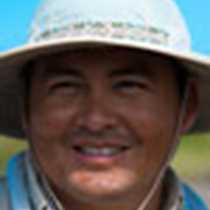Floreana was named after Juan José Flores, the first president of Ecuador, during whose administration the government of Ecuador took possession of the archipelago. It was previously called Charles Island (after King Charles II of England), and Santa Maria after one of the caravels of Columbus.
The island has an area of 173 square kilometers (67 sq mi) and is located in the southern part of the archipelago.
Since the 19th century, Floreana has been a favorite stop for whalers and other visitors to the Galapagos, due to its relatively small size, the fresh water in the lush and green highlands, and a healthy population of giant tortoises. The demands of these visitors, as well as the early settlers and introduced species, devastated much of the local wildlife. Today, the endemic Floreana tortoise is extinct and the endemic Floreana mockingbird is only found on the nearby islands of Gardner and Champion. However, huge efforts to restore the ecosystem of Floreana are currently being carried out by the Galapagos National Park in collaboration with the scientists at the Charles Darwin Station.
This morning we were able to explore the island, with an early pre-breakfast landing at the olivine green beach of Punta Cormorant. This site offers a unique opportunity to see the volcanic landscape and remarkable vegetation of the island. We hiked to a brackish lagoon where many flamingos were found eating, and a white coral sand beach, one of the most important nesting beaches for the Pacific Green sea turtles in the area, where hundreds of nests were found, along with the evidence of turtle tracks from just last night.
After our early outing, we came back for breakfast while the National Geographic Endeavour repositioned to a site near Champion islet, one of the two locations where the remnant population of the Charles mockingbird can be found. We explored this islet with a long Zodiac ride and glass-bottom boat outings, and soon everyone was ready to get into the deep water. Even the heavy rain couldn’t deter the majority of our guests, and they were rewarded with incredible encounters with hundreds of fish, along with white-tipped reef sharks, sea turtles, rays, and the always playful sea lions.
Once all the morning activities were finished, we enjoyed lunch and soon, the ship was again repositioned to a different location, this time to Post Office Bay. Whalers established a wooden barrel at this site, so that mail could be picked up and hand delivered to their destination by other ships that came through on their way home, mainly to Europe and the United States. This tradition is still running, as it has become very known among the visitors of the Galapagos, and so our guests had the opportunity to leave a postcard without any postage, and to look through the letters to see if they could hand deliver any themselves.
After learning about the unique human history of this island, the same island that Charles Darwin visited in 1835, we continued our exploration with our zodiacs and kayaks until late in the afternoon, when it was time to enjoy sunset out on deck with a nice cocktail, as the ship sailed away from this unique and mysterious island…










